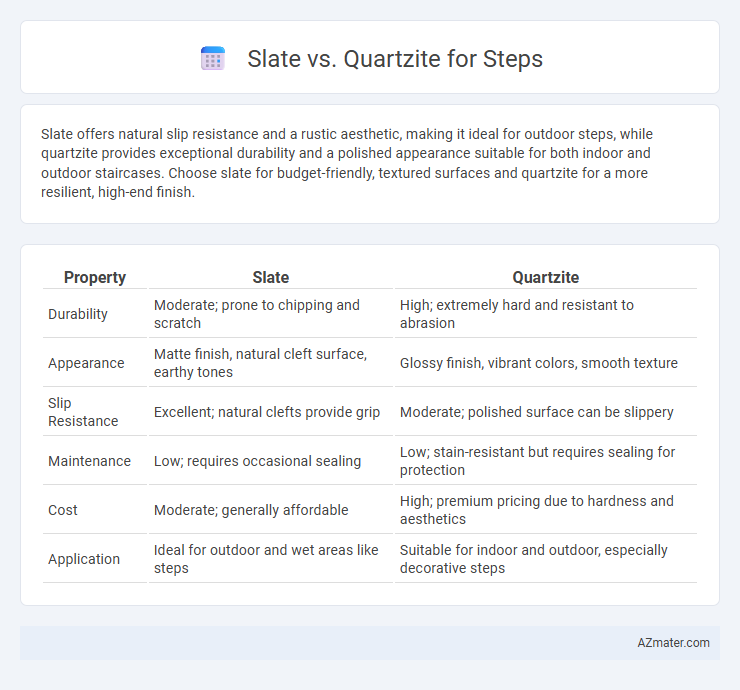Slate offers natural slip resistance and a rustic aesthetic, making it ideal for outdoor steps, while quartzite provides exceptional durability and a polished appearance suitable for both indoor and outdoor staircases. Choose slate for budget-friendly, textured surfaces and quartzite for a more resilient, high-end finish.
Table of Comparison
| Property | Slate | Quartzite |
|---|---|---|
| Durability | Moderate; prone to chipping and scratch | High; extremely hard and resistant to abrasion |
| Appearance | Matte finish, natural cleft surface, earthy tones | Glossy finish, vibrant colors, smooth texture |
| Slip Resistance | Excellent; natural clefts provide grip | Moderate; polished surface can be slippery |
| Maintenance | Low; requires occasional sealing | Low; stain-resistant but requires sealing for protection |
| Cost | Moderate; generally affordable | High; premium pricing due to hardness and aesthetics |
| Application | Ideal for outdoor and wet areas like steps | Suitable for indoor and outdoor, especially decorative steps |
Introduction: Comparing Slate and Quartzite for Outdoor Steps
Slate and quartzite are popular materials for outdoor steps, valued for their durability and aesthetic appeal. Slate offers a natural, textured surface with excellent slip resistance and a variety of earthy tones, ideal for rustic or traditional landscapes. Quartzite, a metamorphic rock harder than slate, provides superior strength and vibrant colors, making it suitable for high-traffic areas and contemporary designs.
Appearance and Aesthetic Differences
Slate features a fine-grained texture with a natural cleft surface that offers a rustic, matte finish ideal for earthy or traditional step designs. Quartzite presents a harder, crystalline structure with a glossy, polished appearance that enhances brightness and lends a more luxurious, modern aesthetic to stair steps. Color variations in slate range from deep grays and greens to reddish hues, while quartzite showcases vibrant whites, pinks, and blues, providing distinct visual appeal for diverse architectural styles.
Durability and Strength: Slate vs Quartzite
Quartzite offers superior durability and strength compared to slate, making it an excellent choice for high-traffic steps. Its natural composition allows it to resist scratches, chips, and weathering better than slate, which is softer and more prone to cracking under heavy use. Quartzite's hardness and density ensure long-lasting performance, whereas slate may require more maintenance and careful handling to prevent damage.
Slip Resistance and Safety Features
Slate offers excellent slip resistance due to its natural cleft surface, making it a safer option for steps in both indoor and outdoor environments. Quartzite, while harder and more durable, often has a smoother finish that may require additional treatment or texturing to enhance grip and prevent slipping. Choosing slate for steps prioritizes safety by minimizing the risk of falls, especially in wet or high-traffic areas.
Weather Resistance and Longevity
Quartzite offers superior weather resistance compared to slate, making it highly durable for outdoor steps exposed to harsh conditions such as freeze-thaw cycles and heavy rainfall. Its high quartz content ensures excellent hardness and resistance to erosion, resulting in extended longevity with minimal maintenance. Slate, while attractive, tends to be softer and more susceptible to chipping and weather-induced wear, making quartzite the preferred choice for long-lasting, weather-resistant stair materials.
Installation Process and Complexity
Slate requires careful handling during installation due to its natural cleft surface, which demands precise cutting and sealing to prevent chipping and water penetration. Quartzite installation involves cutting through a much harder stone, necessitating specialized diamond blades and professional expertise to achieve clean edges and proper adhesion. Both materials benefit from a stable substrate and professional labor, but quartzite's superior hardness increases complexity and installation time compared to softer, more flexible slate.
Maintenance Requirements and Care
Slate steps demand minimal maintenance with regular sweeping and occasional sealing to preserve their natural texture and prevent moisture absorption. Quartzite steps are highly durable and resistant to stains, requiring only periodic cleaning with mild detergent and sealing every few years to maintain their polished finish. Both materials benefit from prompt removal of debris to avoid surface damage and ensure long-lasting beauty.
Cost Considerations for Slate and Quartzite Steps
Slate steps generally cost between $15 to $30 per square foot, making them a budget-friendly option for outdoor and indoor staircases. Quartzite steps, priced higher at approximately $50 to $100 per square foot, offer superior durability and resistance to heat, scratches, and stains. Cost factors for both materials include slab quality, thickness, installation complexity, and regional availability, with quartzite often requiring professional installation due to its hardness.
Eco-Friendliness and Environmental Impact
Slate, a natural metamorphic rock, is highly eco-friendly due to its durability and minimal processing requirements, which reduce carbon emissions during production. Quartzite, formed from sandstone through intense heat and pressure, also offers environmental benefits but often demands more energy-intensive quarrying and finishing processes. Choosing slate for steps supports sustainability by promoting longer-lasting materials with lower environmental impact compared to the energy consumption associated with quartzite extraction and fabrication.
Conclusion: Choosing the Right Stone for Your Steps
Slate offers a natural, textured surface ideal for slip resistance on steps, while quartzite provides superior durability and a polished, elegant appearance. Quartzite's hardness makes it less prone to chipping and scratching, suitable for high-traffic outdoor steps, whereas slate's layered structure requires regular maintenance to prevent flaking. Select quartzite for longevity and refined aesthetics, and choose slate for a rustic, slip-resistant finish tailored to lighter use.

Infographic: Slate vs Quartzite for Step
 azmater.com
azmater.com